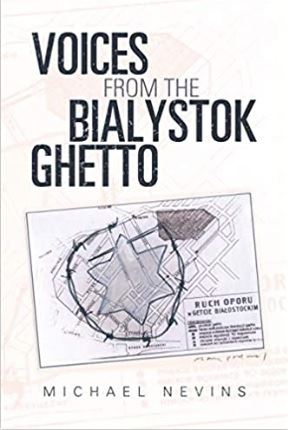 Founded in 1980 |
|
| Michael Nevins, Voices from the
Bialystok Ghetto, Bloomington, IN, iUniverse, 2020. ISBN: 978-1-5320-8864-3. |
Reviewer: Alan Lippman, MD Literature pertaining to the Holocaust is voluminous and heartrending. Especially tragic are diaries recorded by children and young adults who describe personal experiences and feelings simultaneously painful yet banal. Arguably, the exemplar of this genre is considered to be The Diary of Anne Frank, the 13year-old German Jewish girl who lived with her family, and others, hiding in the attic of a condiment factory until they were captured, deported, and subsequently murdered. Anne Frank’s diary is but one of a multitude. The United States Holocaust Memorial Museum lists at least six anthologies and more than 50 individual diaries collected and published during the 75 years since the liberation at the end of World War II.1 Visitors to the Museum, in Washington, DC can view the individual biographies and personal accounts of more than 100 Holocaust-affected men, women, and children who lived in Europe during this fraught time. Add now to the myriad anthologies a new accounting by a master historian, MHSNJ’s own Michael Nevins, here offering intimate insight into the happenings, during the Holocaust, near to his ancestral home, Bialystok, now in northeastern Poland, but originally situated in czarist Russia and home to his paternal grandparents, who lived in a shtetl some 40 miles distant from Bialystok. The central focus of Nevins’ new work is the recently published diary of 18 year-old David Spiro, during the period 1939-43. The period coincides with Bialystok’s occupation by the Russian army and later by the Nazis. Diary entries end abruptly in July 1943, shortly after the siege of the Warsaw ghetto and the further threat of annihilation in Bialystok. David’s poignant final entry tells of his despair: “…my nerves are at their very limit. For some time I have entertained thoughts of suicide but thanks to Lizka and uncle Szmul I managed somehow to stay alive. On July 3 I received a letter from my one and only daddy, my only anchor. My only dream is to survive and see him again….” From archival records, Nevins goes beyond David’s diary, adding the heroic stories of Mordecai Tenenbaum, a young resistance leader, Pesach Kaplan, a social activist and newspaper editor, and others who documented the persecution, humiliation, degradation, and death that confronted the courageous, but hapless Jews of Bialystok. Bialystok was destroyed and its residual Jewish population liquidated in a final pogrom, in July 1943; it is presumed that David Spiro was among the victims. Nevins describes efforts of the few survivors to heal and to rebuild, but notes that of some 300,000 current residents of today’s Bialystok, “only one publicly admits to being Jewish.” Other voices include that of Samuel Pisar, born in Bialystok, whose life was marked by survival of the death camps and emigration to the United States, where he became a renowned international lawyer, honored diplomat, and advisor to presidents. His wife’s friend, Leonard Bernstein, implored him to compose lyrics for his “Kaddish” Symphony No. 3. Merely 82 pages in length, Nevins’ book nevertheless is replete with facts, incisive observations, and lively prose. A few beautiful and clever illustrations by Mark Podwal amplify the message provoked by this remarkable work: “Never again.” --- 1. The United States Holocaust Memorial Museum. https://www.ushmm.org/collections/bibliography/diaries . Website accessed 1/17/20. |
